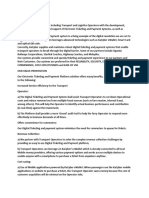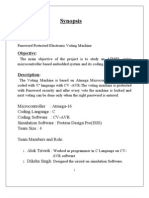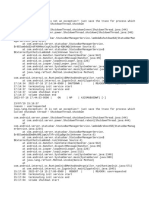Uber Application
Uber Application
Uploaded by
nsh771Copyright:
Available Formats
Uber Application
Uber Application
Uploaded by
nsh771Copyright
Available Formats
Share this document
Did you find this document useful?
Is this content inappropriate?
Copyright:
Available Formats
Uber Application
Uber Application
Uploaded by
nsh771Copyright:
Available Formats
Uber Application
Uber has revolutionized the world of transportation services and has become a role model for its
followers in the market. It is replacing traditional taxi services.
However, Uber is way more complicated than that, as it consists of numerous technologies cooperating
and contributing to the life of the overall app.
Mobile app development: Uber is built with mobile friendliness in mind. It has been built using
mobile app development technologies, mainly iOS and Android development frameworks, to
ensure an intuitive, user-friendly experience both for drivers and riders.
Real-time data processing: The application uses real-time data processing to ensure that both
the riders and drivers are informed about the estimated ride and arrival time. This technology
collects information from GPS sensors, real-time traffic data, and more.
GPS tracking: Uber tracks the location of both the rider and driver using GPS-tracking
technologies. As a result, both can receive real-time location updates and see the car moving on
the map.
Payment processing: Uber’s technologies allow riders to pay for rides using a stored credit card.
This makes the payment process more secure because the rider’s money is stored in the system
and is automatically returned in case the ride is canceled. Moreover, Uber uses integration with
payment processing providers and implements data storage and encryption.
Machine learning: To optimize its ride matching and pricing, Uber uses machine learning
algorithms. They analyze data based on rider behavior, typical rides they take, driver availability,
and patterns in city traffic to improve the ride experience and provide more customized solutions.
Cloud infrastructure: Uber runs on a cloud-based infrastructure, allowing it to scale fast and
process large volumes of data easily.
What programming languages to use when creating an app like Uber?
Python – for a web-based booking app
Node.js – for the Marketplace app
Go – for improved performance and speed
Java – for third-party service integrations
Browserify – for client-side bundling
Apache Hive data warehouse – for data query and analytics
ELk – for processes, shipping, and storing logs
Apache Cassandra – to manage huge volumes of data
MySQL Database Service – for relational database management
Docker – for data center infrastructure
HAProxy – for proxy server and load banner
How difficult is it to build an app like Uber?
Technological sophistication
To process the large amounts of information that Uber stores, it needs to use sophisticated ML
and data analytics platforms built in-house. Real-time data processing, GPS tracking, mobile app
development, payment processing, and other technologies demand extensive expertise and
experience in their development and integration. Therefore, you would need a team ready to
handle all the technical difficulties and create a seamless, user-friendly app.
Compliance with regulations
Building an app like Uber requires you to comply with evolving and constantly changing rules
and regulations. Therefore, it is vital to understand these rules and be able to comply with them,
or else you won’t be able to release the app.
Obligatory scalability
Ride-sharing services should be able to handle large volumes of data and scale up according to
changing requirements. The more people will use your app and the more it grows, the more
scalable it should be. It can be an issue for some business owners because building a scalable
infrastructure requires a lot of effort, time, and money.
Safety and security
Apps that collect personal information about users should be extra secure and safe. This should
be your top priority when building an app like Uber. It involves checking the drivers’
background, tracking rides, ensuring that payments are secure and that all user data is protected
against data breaches and other unexpected issues.
Saturated market
When Uber entered the market in 2010, it was competing only with traditional taxi service
providers. Now, there are numerous similar players who are competing for market share. Entering
such a saturated market is not an easy task, so you need to understand the trends in the market,
and its landscape, research your competitors thoroughly, and be able to provide unique solutions
that, right now, have no alternatives.
Expensive venture
If anyone tells you that developing an app like Uber is not expensive – do not believe them. It is a
costly endeavor because of the technologies used, the need to work with an experienced
development team, and the need to build a scalable infrastructure.
Conclusion
In my opinion, I/m seeing this technologies will have a high effect and help the people such as: machine
learning, cloud storage and real time processing …etc in many different fields such as: health, education,
finance, food and many fields serve the users .
Ref: Developing an Uber-like app: the tech stack and software architecture (intellisoft.io)
You might also like
- Ewhore 2Document29 pagesEwhore 2Camilo lopez100% (1)
- Taxi Service Delivery App ProposalDocument12 pagesTaxi Service Delivery App ProposalBenjamin Bala100% (1)
- Uber MisDocument4 pagesUber Misanon_5707411030% (3)
- Building Mobile Apps at Scale: 39 Engineering ChallengesFrom EverandBuilding Mobile Apps at Scale: 39 Engineering ChallengesRating: 5 out of 5 stars5/5 (2)
- Case UberDocument9 pagesCase Ubermohit chaudharyNo ratings yet
- Uber Case StudyDocument3 pagesUber Case StudyRP17 CE21No ratings yet
- Practice Test 3Document9 pagesPractice Test 3Alexandre50% (2)
- AIB Case Study On UberDocument7 pagesAIB Case Study On UberISHITA NAGPALNo ratings yet
- Sohair SE As3Document7 pagesSohair SE As3yasar khanNo ratings yet
- Online Parking ReservationDocument13 pagesOnline Parking ReservationYesha PatelNo ratings yet
- Durshal Proposal MardanDocument4 pagesDurshal Proposal MardanMuhammad Rizwan Khan UsafzaiNo ratings yet
- Motawash Semeen Chowdhury: ParkhereDocument8 pagesMotawash Semeen Chowdhury: ParkhereTasnova Rebonya 201-15-14170No ratings yet
- Ayandutta 2023julb01104 UberDocument11 pagesAyandutta 2023julb01104 UberAMARTYA MAJUMDERNo ratings yet
- Final Project Uber Technologies Incorporation BY Nayyer Husnain (BBA-4-C) ROLL NO: 2191121Document18 pagesFinal Project Uber Technologies Incorporation BY Nayyer Husnain (BBA-4-C) ROLL NO: 2191121HmazaNo ratings yet
- UBER AlternativesDocument1 pageUBER AlternativesCJ IbaleNo ratings yet
- 6 1 ERP Case Study Can Uber Be The Uber of EverythingDocument9 pages6 1 ERP Case Study Can Uber Be The Uber of EverythingpgkshirsagarNo ratings yet
- 2 - Sample - Assignment (Do Not Copy)Document16 pages2 - Sample - Assignment (Do Not Copy)Mahnoor RehmanNo ratings yet
- Software Engg AssignmentDocument14 pagesSoftware Engg AssignmentNaman VeerNo ratings yet
- Insert An Appropriate Title HereDocument11 pagesInsert An Appropriate Title HereEstherLiNo ratings yet
- Project Appraisal Startup-Urbanclap Presented At: Department of Business Economics Presented By: AINESH (508) SHRISHMADocument10 pagesProject Appraisal Startup-Urbanclap Presented At: Department of Business Economics Presented By: AINESH (508) SHRISHMAnaughty ajayNo ratings yet
- Uber Final PDFDocument17 pagesUber Final PDFteja reddyNo ratings yet
- Chittagong Independent University: SUMMER-2021 / CASE#01/SECTION#01Document8 pagesChittagong Independent University: SUMMER-2021 / CASE#01/SECTION#01Md. Ayman IqbalNo ratings yet
- Chittagong Independent University: SUMMER-2021 / CASE#01/SECTION#01Document8 pagesChittagong Independent University: SUMMER-2021 / CASE#01/SECTION#01Md. Ayman IqbalNo ratings yet
- Synopsis Uber Clone VanshiDocument11 pagesSynopsis Uber Clone Vanshiv85433682No ratings yet
- Major PPT GRP No 13 CCVTDocument13 pagesMajor PPT GRP No 13 CCVTrafxen1234No ratings yet
- 7ps Service MarketingDocument5 pages7ps Service MarketingneethuNo ratings yet
- Research PaperDocument5 pagesResearch Paperradhika2020cs044No ratings yet
- Literature Review On Online Bus TicketingDocument4 pagesLiterature Review On Online Bus Ticketingfeiaozukg100% (1)
- Mwa4 RojoDocument4 pagesMwa4 RojoJoanna RojoNo ratings yet
- On-Demand Taxi Booking App CloneDocument3 pagesOn-Demand Taxi Booking App CloneWebmonde Softtech SolutionsNo ratings yet
- 6 1 ERP Case Study Can Uber Be The Uber of EverythingDocument6 pages6 1 ERP Case Study Can Uber Be The Uber of EverythingpgkshirsagarNo ratings yet
- IntroDocument18 pagesIntroLOLNo ratings yet
- Project Appraisal PPT 2Document9 pagesProject Appraisal PPT 2AkankshaRastogi50% (4)
- Case Study (Orbitz) (MIS442) (Section-8) Book Pg-446Document4 pagesCase Study (Orbitz) (MIS442) (Section-8) Book Pg-446Anika MariamNo ratings yet
- Analysis and Review of GrabTaxi As A Mobile Application For Urban Society - A SurveyDocument18 pagesAnalysis and Review of GrabTaxi As A Mobile Application For Urban Society - A SurveyRien Pratama Idrus67% (3)
- ICT and Ridesourcing (Farin NJ)Document5 pagesICT and Ridesourcing (Farin NJ)Esty HerdianiNo ratings yet
- Rubix - 1Document6 pagesRubix - 1Gaurav KumarNo ratings yet
- EV SynopsisDocument10 pagesEV Synopsissuresh mpNo ratings yet
- Development of A Mobile Airline Reservation ApplicationDocument2 pagesDevelopment of A Mobile Airline Reservation ApplicationRoxanne EspirituNo ratings yet
- Application SpecificationsDocument2 pagesApplication Specificationsbazamafaraj97No ratings yet
- Title Year DescriptionDocument2 pagesTitle Year DescriptionM. Rizki KurniawanNo ratings yet
- 01-12-2020 Chap 1 2 and 3Document31 pages01-12-2020 Chap 1 2 and 3Vince Martin De GuzmanNo ratings yet
- References TFNSWDocument4 pagesReferences TFNSWTarik DemnatiNo ratings yet
- Summary For PaperDocument21 pagesSummary For PaperWhatever ?No ratings yet
- SHEGODocument16 pagesSHEGOD131Shruti SenNo ratings yet
- Why UBER Continue As A TechnologyDocument10 pagesWhy UBER Continue As A Technologylouella.ledesma051492No ratings yet
- JPNR - S10 - 338Document7 pagesJPNR - S10 - 338ShilpaNo ratings yet
- E-Trans: Commercial Transportation ServicesDocument11 pagesE-Trans: Commercial Transportation ServicesUbaid176No ratings yet
- Java and IoT The Intelligent Platform For The Connected VehicleDocument13 pagesJava and IoT The Intelligent Platform For The Connected Vehicleamhosny64No ratings yet
- Smart Car Parking and It's TechnologyDocument4 pagesSmart Car Parking and It's TechnologyRahulSarkerNo ratings yet
- E-Mobility ProposalDocument3 pagesE-Mobility ProposalEmma SNo ratings yet
- Royex Company Profile 2021Document20 pagesRoyex Company Profile 2021Rajib RoyNo ratings yet
- Uber Technologies Inc.: Managing Opportunities and ChallengesDocument12 pagesUber Technologies Inc.: Managing Opportunities and ChallengesAnuj KushwahaNo ratings yet
- Survey On Smart Taxi Booking System Ijariie18646Document4 pagesSurvey On Smart Taxi Booking System Ijariie18646Soressa HassenNo ratings yet
- Software Architecture - Assignment 2 - Aditya IyerDocument7 pagesSoftware Architecture - Assignment 2 - Aditya Iyersetija7490No ratings yet
- Bus Ticketing System ThesisDocument4 pagesBus Ticketing System Thesisalexismillerspringfield100% (3)
- Infosys.110 Business Systems: Deliverable 2: Business Section 2014Document10 pagesInfosys.110 Business Systems: Deliverable 2: Business Section 2014LouisLuoNo ratings yet
- 4.BMC UberDocument7 pages4.BMC Uberjayaprakasam1412No ratings yet
- Auto Sawari-An Android Application: Ambekar Vinita V, Chaudhari Sayali P, Dusane Mansi R, Gawali Snehal SDocument2 pagesAuto Sawari-An Android Application: Ambekar Vinita V, Chaudhari Sayali P, Dusane Mansi R, Gawali Snehal SerpublicationNo ratings yet
- Uber CaseDocument2 pagesUber CaseLê Quang KhangNo ratings yet
- Parking App SystemDocument14 pagesParking App SystemRohit NimbalkarNo ratings yet
- The Smart City Odyssey: Unveiling the Secrets to Traveller-Centric SoftwareFrom EverandThe Smart City Odyssey: Unveiling the Secrets to Traveller-Centric SoftwareNo ratings yet
- Servicenow Interview Question and AnswersDocument72 pagesServicenow Interview Question and Answersswapneshsurwade29No ratings yet
- IDG Authentication Methods Data SheetDocument8 pagesIDG Authentication Methods Data SheetAlexander RodriguezNo ratings yet
- MOTOTRBO Integration Overview R1.1Document14 pagesMOTOTRBO Integration Overview R1.1jcuervoNo ratings yet
- Mini Project SynopsisDocument5 pagesMini Project SynopsisAlok Trivedi100% (1)
- MIC Chapter 1Document62 pagesMIC Chapter 1Shivam †No ratings yet
- ASAP Methodology by SijoDocument8 pagesASAP Methodology by SijoAkshay GodhamgaonkarNo ratings yet
- EN-LocalView For Windows-Operating ManualDocument32 pagesEN-LocalView For Windows-Operating ManualMarcel ZoubekNo ratings yet
- O Level Paper 1 Chapter 1 Start To Binary AdditionDocument3 pagesO Level Paper 1 Chapter 1 Start To Binary AdditionWasim nazirNo ratings yet
- Ice Technology Lab: Front End DeveloperDocument29 pagesIce Technology Lab: Front End DeveloperVivek RaushanNo ratings yet
- Developing Custom Pipeline Components - BizTalk Server - Microsoft DocsDocument2 pagesDeveloping Custom Pipeline Components - BizTalk Server - Microsoft DocspruebaNo ratings yet
- CT7075 Information Security Management - K Poowanendiran FeedbackDocument6 pagesCT7075 Information Security Management - K Poowanendiran FeedbackKulandavel PoowanendiranNo ratings yet
- Mini Project Stqa ReportDocument13 pagesMini Project Stqa ReportUrvi SinghNo ratings yet
- BIM - Project Execution Planning Guide-V2.0 PDFDocument126 pagesBIM - Project Execution Planning Guide-V2.0 PDFCarmen LunaNo ratings yet
- IP Unit 1Document35 pagesIP Unit 1Harsh GuptaNo ratings yet
- Big Book of Excel Vba MacrosDocument176 pagesBig Book of Excel Vba MacrosFerhat DurmuşNo ratings yet
- Review of Related LiteratureDocument4 pagesReview of Related LiteratureJam JamNo ratings yet
- Abhi Intership Weekly Report PDFDocument6 pagesAbhi Intership Weekly Report PDFSammed HuchchannavarNo ratings yet
- Power Off Reset Reason BackupDocument5 pagesPower Off Reset Reason Backupjohana llerena alvesNo ratings yet
- ChatLog Refresher Program - Java Full Stack - C Programming - Python - Batch1 - Virtual Training at NEC 2021-10-23 13 - 01Document7 pagesChatLog Refresher Program - Java Full Stack - C Programming - Python - Batch1 - Virtual Training at NEC 2021-10-23 13 - 01Chirag yadavNo ratings yet
- Transition Resignation Plan TemplateDocument3 pagesTransition Resignation Plan TemplateBaby AbellaNo ratings yet
- Freelance 2016: Mounting and Installation Instructions AC 900F ControllerDocument156 pagesFreelance 2016: Mounting and Installation Instructions AC 900F ControllerAbdo AbdoNo ratings yet
- Eplan Review Standard Naming ConventionsDocument1 pageEplan Review Standard Naming ConventionsRewayda MahmoudeNo ratings yet
- Application Security Vulnerabilities-Part1Document55 pagesApplication Security Vulnerabilities-Part1issa.i.shabanNo ratings yet
- Database Management System 17: Normal FormsDocument16 pagesDatabase Management System 17: Normal Forms089ASHUTOSH PATINo ratings yet
- Modular Servo System: User's ManualDocument72 pagesModular Servo System: User's ManualFazli WadoodNo ratings yet
- Final Strike PDF 22-23 (SE+SE diploma+TE) PDFDocument2 pagesFinal Strike PDF 22-23 (SE+SE diploma+TE) PDFMOVIETADKANo ratings yet
- Accessing Vcenter ServerDocument40 pagesAccessing Vcenter ServerNemoNo ratings yet
- Use Keyboard Shortcuts To Deliver Your Presentation - PowerPointDocument4 pagesUse Keyboard Shortcuts To Deliver Your Presentation - PowerPointNavs RadioNo ratings yet

























































































